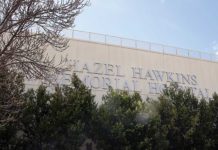
Secretary of Interior Ken Salazar said the National Park Service is striving to become a place that is more inclusive and the redesignation ceremony Monday surely reflected that effort.
Look back for video of the event later this week.
It is estimated that between 500 to 700 people attended a celebration to honor the upgrade of Pinnacles from a monument to a national park on a winter day that was sunny and clear. The groups in attendance included Native Americans who count ancestors as some of the first to live in the south county region, descendants of homesteaders who settled the land and school children who attend nearby Jefferson Elementary School and others who were enthusiastic about the outdoors.
“I’m so glad to see you all here today and so glad to see all the support,” said Karen Beppler-Dorn, the superintendent of Pinnacles National Park.
National Park Service Pacific West Regional Director Chris Lehnertz said national parks comprise one of the most democratic resources in the United States.
“We are here to celebrate what is a people’s place,” Lehnertz said, before introducing Salazar.
Salazar read a letter from President Barack Obama to the crowd and shared his own thoughts on the Department of Interior’s direction.
“By 2016 it will be a more inclusive place for all Americans,” he said, noting that in Seattle, a recent unit of the national parks was created to honor Asian American influence in the Pacific Northwest. “We need to tell the story of all. Of the 2,600 (properties in the National Park Service) only 8 percent recognize the contributions of women, Latinos, Asians and African Americans.”
He noted that the celebration at Pinnacles brought together a wide range of people, from ranchers and farmers to Native Americans and conservationists.
“People ask why this is such an important day,” he said. “Park (status) means jobs. National parks mean jobs. Places with conservation and outdoor recreation have strong tourism.”
With local officials from San Benito and Monterey counties in attendance, including county supervisors and city mayors, Salazar joked about each city scrambling to be the gateway into the park, which has three entrances.
Congressman Sam Farr, who proposed the legislation to turn Pinnacles from a monument into a park, said the idea first came from local residents who suggested it to him early in his political career. The legislation was also supported by Sen. Barbara Boxer.
“President Theodore Roosevelt would be proud of what we have accomplished here,” Farr said, referencing the president who designated Pinnacles as a monument. “He saw the wisdom in preserving this special place for generations of Americans. Today, we honor that legacy by completing his work and elevating Pinnacles to a national park.”
While many in attendance came from nearby communities, some drove from other counties to be part of the historic moment.
“I feel pride,” said Sonya Dorado, who traveled from Bakersfield. “I’m proud and excited. Hopefully, it will be taken care of.”
Dorado and friend Peggi Alvarez count themselves as descendants of the Chalone tribe, which lived in the region before it was settled by homesteaders. Members of the Amah Mutsun tribe were also present at the celebration, with Valentin Lopez offering a prayer song during the redesignation ceremony.
The afternoon activities included an historical walking tour led by Timothy Babalis, a National Park Service historian, around the Ben Bacon Ranch. On the walk, school children from Jefferson Elementary School, as well as the Hollister Dual Language Academy, asked questions of Babalis and kept close to him at the front of the tour. The students participated in the ceremony by citing the Pledge of Allegiance in English and Spanish.
After the walking tour, volunteers and staff members manned booths on different goals of the park that were highlighted in the recent legislation. Visitors learned about the Condor Recovery Program, other wildlife in the park, unique geology of the park and the influence of different cultures throughout the history of the park. Park volunteers set up spotting scopes in hopes of giving visitors a glimpse of condors along a ridge overlooking the east visitor’s center. But on the sunny Monday afternoon, the condors were not cooperating.
Samantha Simmons, an eighth-grade student at Jefferson Elementary School, said she has been to the park many times since her mom works there.
“It’s a very wide open space – you go on walks and hikes,” Simmons said. “It’s all about the environment and where we live.”
Kenia Delgado, a seventh-grade student, said she also likes to walk and hike at Pinnacles.
Simmons said she thought Pinnacles staff members have wanted the monument to become a park for a long time.
“I think for them, it is a big accomplishment,” she said. “It will help with business. A lot of people want to go to parks.”
She noted her family has visited several other national parks.
Delgado said even though she has visited the park many times, she learned some new things on the tour of the Ben Bacon Ranch.
To pull off the influx of people, National Park Service employees from other locations and volunteers came in to help with such tasks as coordinating parking, coordinating refreshments during the reception and helping with logistics.
“People get to enjoy the park,” Beppler-Dorn said. “We can teach our children and our children’s children about the benefit of national parks.”





